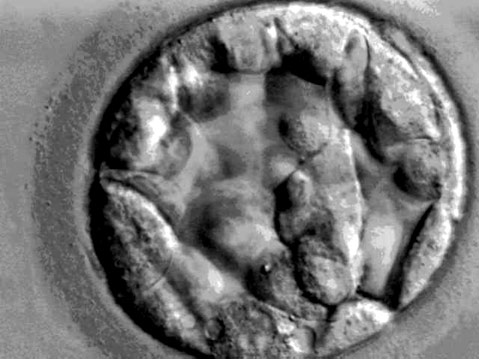Cancer Vaccines: Part III
Vaccinating with Embryonic Tissues

Over the last two weeks, Biology Bytes has covered a variety of cancer vaccine technologies, many of which are in clinical trials and some of which have received FDA-approval. These contemporary vaccines had their roots, naturally, in the laboratory.
In this article, the last of the three-part series on cancer vaccines, we’ll return to the research lab to explore a preliminary cancer vaccine technology: using cells from embryos to help fight cancer. Although this style of vaccine will probably not be entering clinical trials any time soon, the biological lessons learned from these studies are very relevant to our understanding of cancer, and ultimately of how to better fight it.

In 2009, a research article was published by professors Yi Li, Zihai Li, and colleagues (at the University of Connecticut School of Medicine) showing that mice with colon cancer could be “vaccinated” with human embryonic stem cells. Vaccines contain an identifying piece of a potential biological invader (such as a protein only made by a certain virus). When the body is vaccinated, the immune system prepares itself to fight off the invader when it is encountered again (for more information, see the Biology Bytes article “Cancer Vaccines: Part I”). The idea of stimulating the immune system to fight off cancer is steadily gaining support.
But since cancer is threatening to the host, why do our immune systems not attack it in the first place? This problem is called “immune tolerance.” The immune system usually fails to detect and attack cancerous tumors, and consequently many cancer treatments are currently being developed that stimulate the immune system to fight back (e.g. the growing field of cancer vaccines).
An intriguing insight into this state of immune tolerance can be found by looking at what happens to the immune system during pregnancy. It’s been found that the body’s immune response to a tumor is very similar to its response to a developing embryo. This helps explain why the 2009 study above, where mice were vaccinated using human embryonic stem cells, succeeded in treating cancer to some extent; but this is just part of a centuries-old story. The long history of studies illustrate three key points overall: (1) tumors and embryonic tissues have many similar molecules on their cells that are recognized by the immune system, and consequently, antibodies made to identify and attack tumors can do the same to embryonic tissues, and vice versa; (2) pregnancy, amazingly, confers some immunity against cancer; and (3) similar to pregnancy, an immune response against cancer can be generated by vaccinating animals with embryonic tissues.
Tumors and Embryonic Tissues are Viewed Similarly by the Immune System
The first published suggestion that tumors may have an embryonic nature dates all the way back to the late 1830s. It was proposed that tumors might be tissues that had become embryonic-like again. This idea was found later to be fairly accurate: It is now generally accepted that, in terms of the proteins they make, tumors are indeed more “embryonic” than the tissues they are derived from. By the late 1800s, researchers realized that they could better understand and combat cancerous tumors by better understanding normal development.
The focus of these studies shifted because the field of immunology was born (from research conducted by Louis Pasteur and Robert Koch) and many researchers started investigating creating vaccines to cure diseases. Cancer was no exception. As the field of immunology blossomed, in the 1920s and 1930s researchers found that tumors and embryonic tissues make similar molecules recognized by the immune system—molecules not found on non-cancerous adult tissues. (Molecules recognized by the immune system are called “antigens.”) Antibodies can rally the immune system to fight off threatening “invaders” identified by their antigens. So, in the 1960s and 1970s, it was found that antibodies made to specifically recognize animal tumors could also recognize embryos—and vice versa. These studies led to the idea of “oncofetal antigens,” antigens that are made by both tumors and fetal/embryonic tissues.
Pregnancy Confers Some Immunity Against Cancer
Pregnancy is a fascinating biological condition. During the early stages of pregnancy, the immune system in the mother-to-be is actually put on alert against the developing embryo. Specifically, in the 1960s a study reported that about 80% of blood serum (which normally contains antibodies) from pregnant women in the first two trimesters contained antibodies that reacted against embryonic tissue. Why more early pregnancies do not spontaneously abort due to this obvious immune response is still not well understood, but the placenta serves an important role in creating a protective interface between mother and child. However, given the above findings, it may not be too surprising to hear that these antibodies also recognized tumor tissues (but, importantly, not other adult tissues).
As the concept of oncofetal antigens developed, researchers explored a hypothesis with very practical applications: Because pregnant animals develop antibodies that can recognize tumor tissues, pregnancy may partially “vaccinate” an animal against cancer. Early observations in support of this theory are nearly 300 years old, as celibate nuns were thought to have increased incidences of breast, uterine, and ovarian cancer. Some researchers believed that this increased risk might be due to a lack of antibodies generated during pregnancy against embryonic-like tissues. Multiple studies in the 1960s through 1980s found support for this theory, repeatedly showing that women and animals that were multiparous (pregnant multiple times) not only had fewer spontaneous cancers, but multiparous animals were also more resistant to induced tumors (e.g. using known carcinogens in animal studies).
This phenomenon also seems to work the other way around: Correlations have been shown to exist between women with high amounts of antibodies that recognize oncofetal antigens, and low pregnancy rates. Because the antibodies also recognize embryonic tissues (as well as cancer tissues), some women who have had multiple miscarriages (spontaneous abortions) have an (unusually) high amount of these antibodies in their body (presumably all of the time).
Embryonic Tissues Confer Some Cancer Immunity
As researchers found that pregnant animals have some immunity against cancer, the question was raised: Could injecting, or “vaccinating,” with embryonic tissues alone similarly trigger an immune response and confer cancer immunity? In the late 1960s and early 1970s, many reports were published supporting this theory: animals vaccinated with embryonic tissues created antibodies that not only recognized tumors, but could even sometimes prevent the formation of tumors in the animals.
One such astonishing study was published in 1970, when researchers Elliott H. Stonehill and Aaron Bendich (at the Sloan-Kettering Institute for Cancer Research in New York) reported that rabbits immunized with nine-day-old mouse embryos created antibodies that recognized 72 different mouse tumors from 12 different tissue types. The antibodies, as expected, also reacted against embryonic tissues. Similar results were seen with human embryos.
These studies strongly suggest that vaccination with embryonic tissues not only triggers an immune response against cancer, but may also prevent it to some degree.
Overcoming the Problem of Immune Tolerance
But in order to truly harness the potential of using embryonic tissues to immunize against cancer, the problem of immune suppression must be better understood. In pregnant women and in patients with cancer, immune tolerance happens in an apparently similar manner. Its occurrence is both transient, and poorly understood.
In the 1960s, it was reported that while patients with sarcomas usually did not have detectable antibodies against the tumor, after the tumor was surgically removed, anti-tumor antibodies increased! This was not seen in patients whose sarcomas were not successfully removed. Similarly, antibodies against oncofetal antigens are present in pregnant women in the first two trimesters, then quickly disappear during the final trimester, and then reappear after birth.
The cause for the transient immune tolerance in both cases is unclear, though “blocking factors” in blood serum may facilitate this process; they were identified in the early 1970s. These factors most likely (1) prevent recognition of the embryo/cancer and/or (2) suppress the immune system in general (e.g. may include the widely studied factor TGF-beta). Clearly, to better understand immune tolerance in cancer, it would be helpful to better understand immune tolerance in pregnancy. There are probably many shared reasons for why pregnancies and tumors are not rejected by the body more often than they are.
While these studies showed many promising findings for fighting cancer, published reports significantly decreased after the mid-1970s. This was possibly due to decreased funding, and the infeasibility of progressing the studies further because of the dubious ethical nature of such human research. However, the connection between cancer and embryonic tissues/cells has been revisited recently using human embryonic stem cells (hESCs). A stable embryonic cell line had not been available to test in the previous studies.
In 2009, professors Yi Li, Zihai Li, and colleagues (at the University of Connecticut School of Medicine) reported that vaccinating mice with hESCs resulted in an immune response against colon cancer. The hESCs conferred consistent, cellular, and humoral responses against the colon cancer and significantly reduced the tumor size. This report, understandably, is bringing attention back to the longstanding field of cancer vaccination using embryonic tissues and cells. Other groups may also revisit this potentially promising tool for fighting cancer in the burgeoning field of cancer vaccines.
For more on using embryonic tissues and cells as cancer vaccines, see Teisha Rowland’s “All Things Stem Cell post on Cancer Vaccines: Using Embryonic Tissues and Stem Cells to Vaccinate Against Cancer,” a recent review by Brewer, B. G. et al. on “Embryonic Vaccines Against Cancer: An Early History,” the recent article by Li, Y. et al. on vaccinating against colon cancer using human embryonic stem cells, a commentary on this article, or the U.S. National Institutes of Health: National Cancer Institute’s amazing fact sheet on cancer vaccines, including a list of active clinical trials of cancer vaccines.
Biology Bytes author Teisha Rowland is a science writer, blogger at All Things Stem Cell, and graduate student in molecular, cellular, and developmental biology at UCSB, where she studies stem cells. Send any ideas for future columns to her at science@independent.com.



